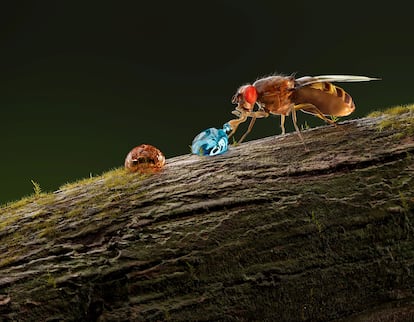Research on fruit flies confirms existence of receptors for alkaline food
‘Drosophila melanogaster’ can detect what amounts to a sixth taste, helping it avoid harmful substances. Scientists hope to find similar high-pH detectors in mammals

Flies can get more flavor out of food than humans. The latter, like all mammals, have receptors on their tongues for sweet, salty, bitter and sour foods. A few decades ago, researchers discovered specific receptors for a fifth basic taste, umami. Now, a group of scientists has shown that the fruit fly (Drosophila melanogaster) can detect what amounts to a sixth taste, for alkaline foods. The ability to detect substances with a high pH, such as caustic soda, would give them an advantage when it comes to avoiding harmful food and potentially dangerous environments.
Before humans gave it another cultural function (enjoyment), the sense of taste was a way to handle scarcity. Animals are programmed to go hungry, and taste gives them clues as to how nutritious a food item is. But this sense also serves as a sentinel: it warns that a compound may be in bad state and harmful. The physiology and chemistry of all living beings develops in environments with a neutral pH (with a value of 7). Extremely acidic substances such as hydrochloric acid, with its pH of 0, for example, are incompatible with life. But the same thing happens with very alkaline substances (sodium hydroxide has a pH of 14). However, while other animals such as cats are thought to have the ability to detect high pH as well, it had only been demonstrated in one species of beetles.
To that very short list we must now add the fruit fly. Scientists from the University of California, the Chinese Academy of Sciences and the Monell Chemical Senses Center in Philadelphia have discovered that fruit flies have receptors specifically dedicated to detecting alkaline substances. This is one of the most common animals in laboratories. Its genome is made up of just over 15,000 genes (humans have just over 20,000) and it serves as a model to study many human diseases. But even if all its genes have been identified, the role of most of these is still unknown.
In a paper published in the scientific journal Nature Metabolism, researchers documented their discovery in this genetic haystack of a gene that they have called alka, because it hides the instructions to detect a substance’s alkalinity.
“Flies detect different flavors using mainly gustatory receptor neurons (GRNs) analogous to human taste receptor cells, present in the labellum, equivalent to our tongue,” says Yali V. Zhang, a biochemist at the Monell Center and lead author of the discovery. “In addition, they also use the GRN from the tarsi of their legs to detect taste substances.” That is to say, when they land they already know if that substance is sweet, acid... or alkaline, as has been shown by the recent research.
Mutant flies
To find out, they used the CRISPR gene editing technique, obtaining dozens of mutant flies that were missing a certain gene that they presumed to be related to the senses (one of the authors, Craig Montell, from the University of California, has spent years identifying fruit fly sensory receptors). They placed two drops in front of the flies, one filled with glucose and the other with the same sugar, but to which they added sodium hydroxide, also known as caustic soda, one of the most alkaline bases there is. All the insects whose genes were not manipulated chose the sweet solution, avoiding the alkaline one. The same thing happened with almost all the mutants, except for some where the expression of a gene with unknown functions called CG12344 had been blocked. These flies exhibited a reduced aversion to alkaline substances. They even preferred droplets of sodium hydroxide if the concentration was not very high.
As there was the possibility that this attraction was due to the salt in the compound (sodium), the researchers then created flies with a double mutation, one so that they would not reject the sodium hydroxide and another one to prevent them from perceiving its salty taste. Again, these flies did not avoid the alkaline solution. In their eagerness to rule out alternative explanations, researchers observed how the different flies extended or retracted their proboscis, which they use to feed. The mutant flies did not retract it when they detected the high pH substance. To make sure this reaction was not due to the compound itself, which is very alkaline, they repeated the tests with a different base, sodium carbonate, which has a lower pH. They got the same results again. In another series of extreme experiments, the scientists manipulated the alkaline taste neurons of various insects by stimulating the proboscis with red LED light. When brightly illuminated with the red end of the spectrum, this activation of GRNs made the insects not only prefer the basic flavor, but also avoid the sweet one.
“When we activate the GRNs by exposing them to red light, the flies perceive the taste of sucrose as alkaline, so they reject the sucrose that, under normal conditions, would be attractive to them. This indicates that the alkaline taste can suppress the sweet taste,” explains Zhang. “When you add something bitter, like caffeine, to a cup of chocolate milk, it will decrease its sweet taste and even make it bitter because the caffeine suppresses the sweet taste.” Zhang and his colleagues renamed the CG12344 gene, calling it Alka. They had earned the right to do so, after identifying the gene, finding its function, and showing how flies can detect alkalinity.
Not all alkaline substances are necessarily toxic, but most are. “The pH is important for all living organisms, as they need their food to be within a specific pH range to survive,” notes Zhang. “In addition, it plays an essential role in the metabolism, physiology and nutrition of organisms, because many biological processes, such as enzymatic reactions, require precise pH levels (a pH of 7.4) to occur,” he adds. Alkaline substances are widely present in ecosystems and “strong alkalinity is physiologically harmful, causing alkalosis.”
Humans have lost the ability, but in the rest of the animal world, if you don’t detect a toxic compound, you dieJuan Alcañiz, researcher at the Institute of Neurosciences at Miguel Hernández University
Juan Alcañiz, who studies the senses of D. melanogaster at the Institute of Neurosciences in Miguel Hernández University in Spain, highlights the sentinel value of these newly discovered receptors. “It’s not just about the food. The females then have to lay their eggs and they have to avoid alkaline environments,” he recalls. This may give them an evolutionary advantage and most likely it is also to be found in other insects and, why not, in mammals. Alcañiz also draws attention to the fact that taste is such an essential sense that there are hardly any pathologies of the taste system. “Humans have lost the ability, but in the rest of the animal world, if you don’t detect a toxic compound, you die.”
The difficult thing is to know if this is also present in humans. The logic behind the system used by flies and humans is similar: taste cells detect the same molecules by sending a series of signals to the brain. But the receptors of insects and mammals have nothing to do with each other. Francisco Martín, who studies the molecular physiology of behavior at the Cajal Institute (CSIC), notes that “vertebrates don’t even have the fly gene.” But both experts agree that this new discovery opens the way to search for these basic receptors in humans.
Sign up for our weekly newsletter to get more English-language news coverage from EL PAÍS USA Edition
Tu suscripción se está usando en otro dispositivo
¿Quieres añadir otro usuario a tu suscripción?
Si continúas leyendo en este dispositivo, no se podrá leer en el otro.
FlechaTu suscripción se está usando en otro dispositivo y solo puedes acceder a EL PAÍS desde un dispositivo a la vez.
Si quieres compartir tu cuenta, cambia tu suscripción a la modalidad Premium, así podrás añadir otro usuario. Cada uno accederá con su propia cuenta de email, lo que os permitirá personalizar vuestra experiencia en EL PAÍS.
¿Tienes una suscripción de empresa? Accede aquí para contratar más cuentas.
En el caso de no saber quién está usando tu cuenta, te recomendamos cambiar tu contraseña aquí.
Si decides continuar compartiendo tu cuenta, este mensaje se mostrará en tu dispositivo y en el de la otra persona que está usando tu cuenta de forma indefinida, afectando a tu experiencia de lectura. Puedes consultar aquí los términos y condiciones de la suscripción digital.
More information
Últimas noticias
Most viewed
- Sinaloa Cartel war is taking its toll on Los Chapitos
- Reinhard Genzel, Nobel laureate in physics: ‘One-minute videos will never give you the truth’
- Oona Chaplin: ‘I told James Cameron that I was living in a treehouse and starting a permaculture project with a friend’
- Why the price of coffee has skyrocketed: from Brazilian plantations to specialty coffee houses
- David King, chemist: ‘There are scientists studying how to cool the planet; nobody should stop these experiments from happening’











































